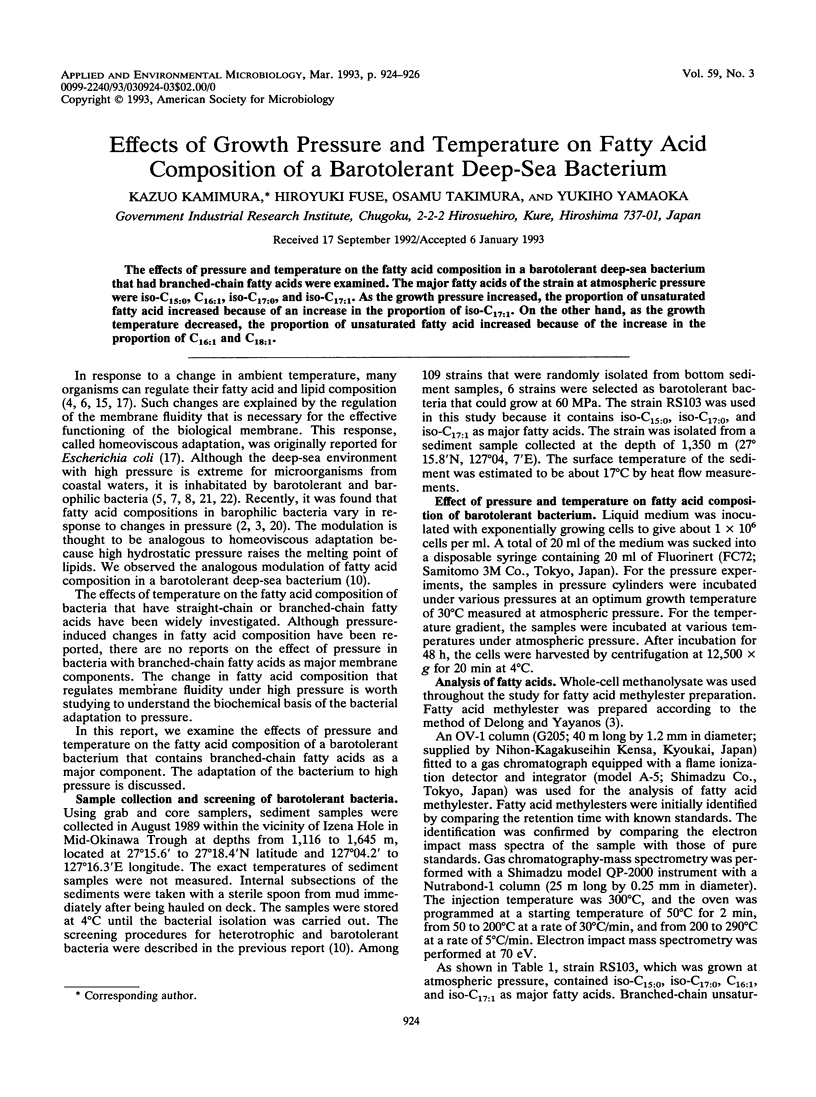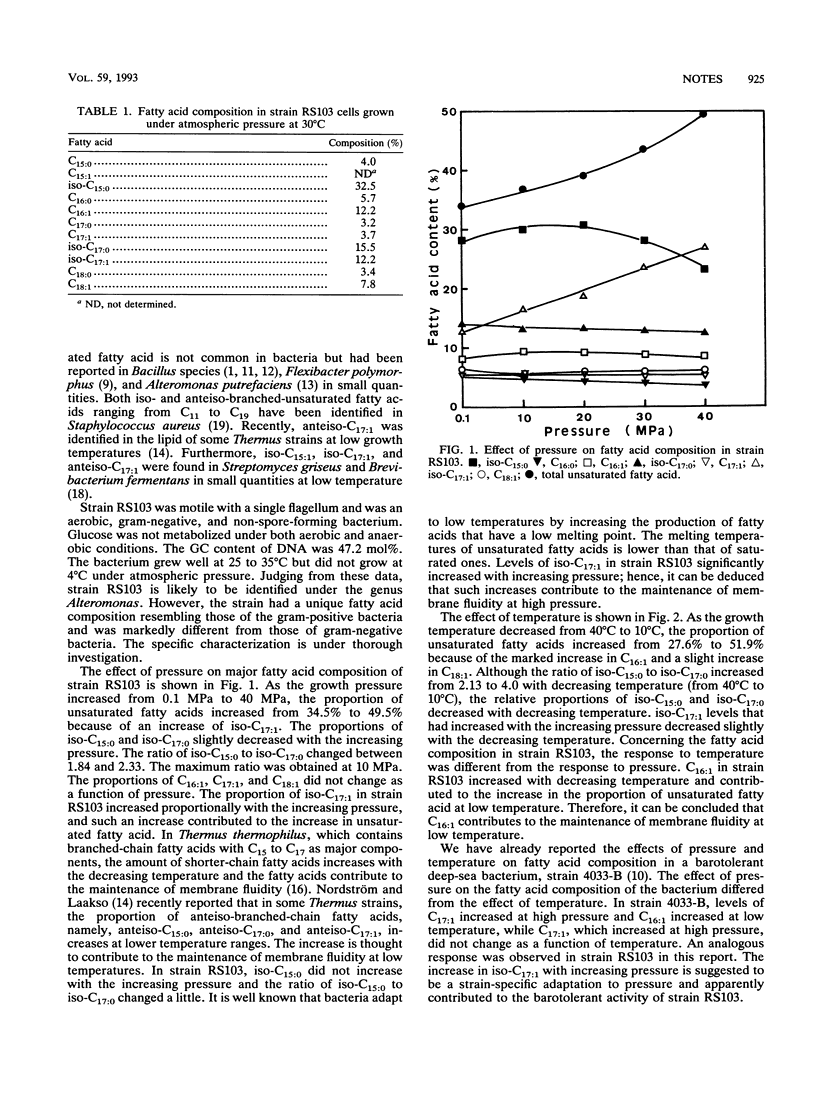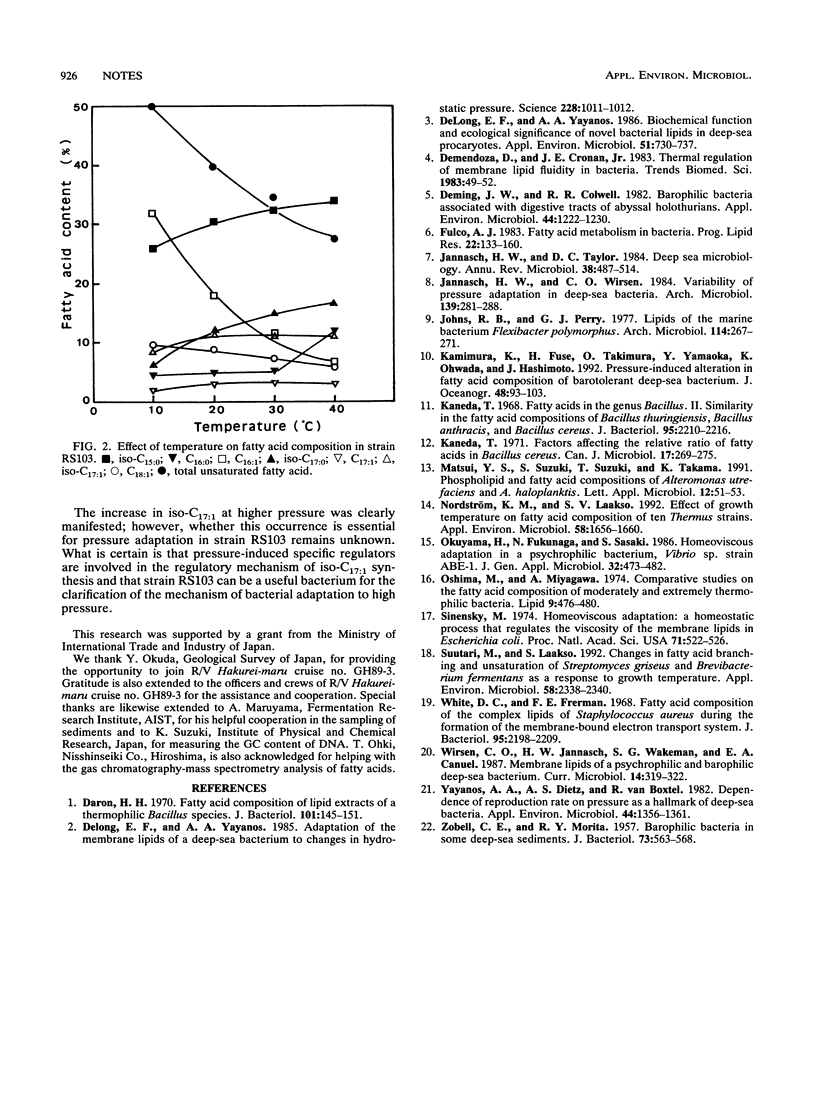Abstract
The effects of pressure and temperature on the fatty acid composition in a barotolerant deep-sea bacterium that had branched-chain fatty acids were examined. The major fatty acids of the strain at atmospheric pressure were iso-C15:0, C16:1, iso-C17:0, and iso-C17:1. As the growth pressure increased, the proportion of unsaturated fatty acid increased because of an increase in the proportion of iso-C17:1. On the other hand, as the growth temperature decreased, the proportion of unsaturated fatty acid increased because of the increase in the proportion of C16:1 and C18:1.
Full text
PDF


Selected References
These references are in PubMed. This may not be the complete list of references from this article.
- Batra L. R., Batra S. W. Floral Mimicry Induced by Mummy-Berry Fungus Exploits Host's Pollinators as Vectors. Science. 1985 May 24;228(4702):1011–1013. doi: 10.1126/science.228.4702.1011. [DOI] [PubMed] [Google Scholar]
- Daron H. H. Fatty acid composition of lipid extracts of a thermophilic Bacillus species. J Bacteriol. 1970 Jan;101(1):145–151. doi: 10.1128/jb.101.1.145-151.1970. [DOI] [PMC free article] [PubMed] [Google Scholar]
- Delong E. F., Yayanos A. A. Biochemical function and ecological significance of novel bacterial lipids in deep-sea procaryotes. Appl Environ Microbiol. 1986 Apr;51(4):730–737. doi: 10.1128/aem.51.4.730-737.1986. [DOI] [PMC free article] [PubMed] [Google Scholar]
- Deming J. W., Colwell R. R. Barophilic bacteria associated with digestive tracts of abyssal holothurians. Appl Environ Microbiol. 1982 Nov;44(5):1222–1230. doi: 10.1128/aem.44.5.1222-1230.1982. [DOI] [PMC free article] [PubMed] [Google Scholar]
- Fulco A. J. Fatty acid metabolism in bacteria. Prog Lipid Res. 1983;22(2):133–160. doi: 10.1016/0163-7827(83)90005-x. [DOI] [PubMed] [Google Scholar]
- Jannasch H. W., Taylor C. D. Deep-sea microbiology. Annu Rev Microbiol. 1984;38:487–514. doi: 10.1146/annurev.mi.38.100184.002415. [DOI] [PubMed] [Google Scholar]
- Kaneda T. Factors affecting the relative ratio of fatty acids in Bacillus cereus. Can J Microbiol. 1971 Feb;17(2):269–275. doi: 10.1139/m71-045. [DOI] [PubMed] [Google Scholar]
- Kaneda T. Fatty acids in the genus Bacillus. II. Similarity in the fatty acid compositions of Bacillus thuringiensis, Bacillus anthracis, and Bacillus cereus. J Bacteriol. 1968 Jun;95(6):2210–2216. doi: 10.1128/jb.95.6.2210-2216.1968. [DOI] [PMC free article] [PubMed] [Google Scholar]
- Nordström K. M., Laakso S. V. Effect of growth temperature on fatty acid composition of ten thermus strains. Appl Environ Microbiol. 1992 May;58(5):1656–1660. doi: 10.1128/aem.58.5.1656-1660.1992. [DOI] [PMC free article] [PubMed] [Google Scholar]
- Oshima M., Miyagawa A. Comparative studies on the fatty acid composition of moderately and extremely thermophilic bacteria. Lipids. 1974 Jul;9(7):476–480. doi: 10.1007/BF02534274. [DOI] [PubMed] [Google Scholar]
- Sinensky M. Homeoviscous adaptation--a homeostatic process that regulates the viscosity of membrane lipids in Escherichia coli. Proc Natl Acad Sci U S A. 1974 Feb;71(2):522–525. doi: 10.1073/pnas.71.2.522. [DOI] [PMC free article] [PubMed] [Google Scholar]
- Suutari M., Laakso S. Changes in fatty acid branching and unsaturation of Streptomyces griseus and Brevibacterium fermentans as a response to growth temperature. Appl Environ Microbiol. 1992 Jul;58(7):2338–2340. doi: 10.1128/aem.58.7.2338-2340.1992. [DOI] [PMC free article] [PubMed] [Google Scholar]
- White D. C., Frerman F. E. Fatty acid composition of the complex lipids of Staphylococcus aureus during the formation of the membrane-bound electron transport system. J Bacteriol. 1968 Jun;95(6):2198–2209. doi: 10.1128/jb.95.6.2198-2209.1968. [DOI] [PMC free article] [PubMed] [Google Scholar]
- Yayanos A. A., Dietz A. S., Van Boxtel R. Dependence of reproduction rate on pressure as a hallmark of deep-sea bacteria. Appl Environ Microbiol. 1982 Dec;44(6):1356–1361. doi: 10.1128/aem.44.6.1356-1361.1982. [DOI] [PMC free article] [PubMed] [Google Scholar]
- ZOBELL C. E., MORITA R. Y. Barophilic bacteria in some deep sea sediments. J Bacteriol. 1957 Apr;73(4):563–568. doi: 10.1128/jb.73.4.563-568.1957. [DOI] [PMC free article] [PubMed] [Google Scholar]


